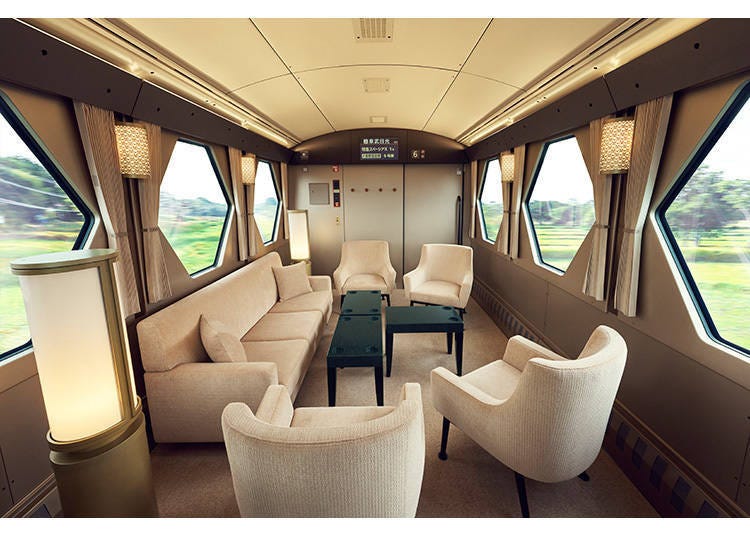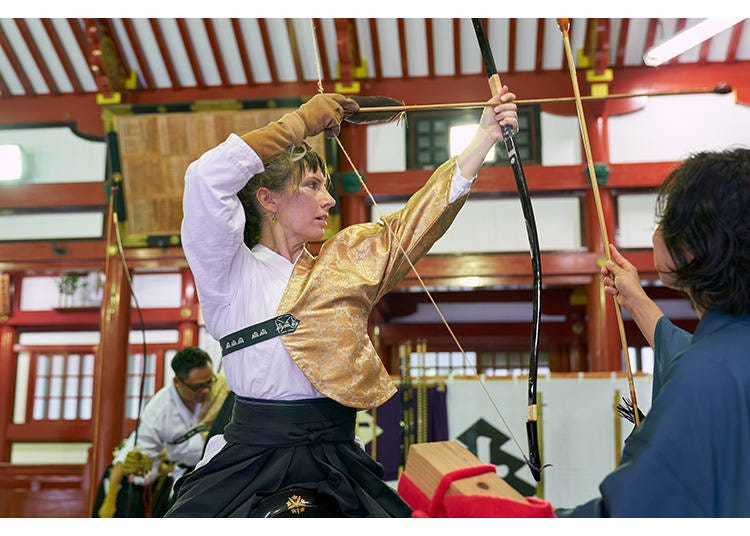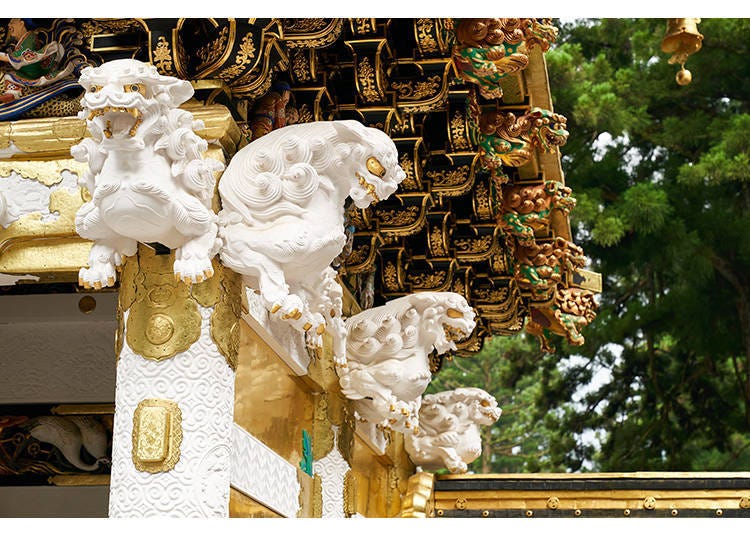
Nikko is a must-see historic city in easy reach of Tokyo. You just hop on the train and before you know it you have stepped back in time to pre-modern Japan. It is also a pretty compact city with most of the famous sites within comfy walking distance. However, despite the easy access, it can be harder to go beyond the surface and get to the heart of what makes Nikko special. That is why tours like the Shogun Story have been developed to give visitors a taste of the real Nikko, one that even Japanese people rarely get to see.
Join us as we ride a luxurious train, try our hand at archery, and savor an encounter with fine dining as we experience this unique cultural tour.
Relive the formative years of Japan as we know it

As one of Japan’s premier travel destinations, Nikko is well known for its ornate World Heritage shrines and temples, which are steeped in spiritual and samurai tradition. Toshogu Shrine is the crown jewel of Nikko, with some of the most elaborate and beautiful ornamentation of any structure in Japan. It is the mausoleum of Tokugawa Ieyasu (1543-1616), the shogun who succeeded in unifying Japan, ushering in the peaceful and prosperous Edo period (1603-1867). Ieyasu requested that upon his death his remains be interred in the town of his birth for one year, then enshrined here at Toshogu Shrine. From Nikko, located 130 kilometers north of Edo (present-day Tokyo), Ieyasu could watch over his capital. First as ruler, then as a deity, he wished to guard the nation. For hundreds of years, shoguns and daimyos made pilgrimages to Nikko to pay their respects to Ieyasu and pray for guidance. To this day, Toshogu remains one of the most visited shrines in Japan.

Nikko also has a connection with the Ogasawara, an ancient and elite samurai clan known not only for their skill on the battlefield but also for their grace at court. The clan was so accomplished that its members were called upon to train the samurai of shogun armies in the Ogasawara-ryu, a school of martial arts specializing in archery, mounted archery, and reiho etiquette. The Ogasawara trained samurai for the duration of shogunate rule, from its beginning in 1192 to its collapse in 1867.

Westward into the mountains from Toshogu Shrine lies Nikko National Park, designated as a park in 1934 but known for its stunning nature since time immemorial. Lake Chuzenji is a highlight of the park, its forested shores offering a cool respite from the summer heat and a blaze of colors come autumn. With air conditioning not yet invented in the Meiji period (1868-1912), wealthy Europeans living in Japan built villas here on the lake.

Embark on the Shogun Story Tour
The Shogun Story Tour is a journey to and through Nikko, offering explorations into the realm of high Japanese culture through exclusive access to Toshogu Shrine and members of the Ogasawara clan. This two-day, one-night full-service tour features not only deep experiences, but also accommodation at a historic Nikko hotel and transportation via the luxurious Spacia X limited express train.
Train Journey Aboard Spacia X

The Shogun Story tour starts from Tobu Asakusa Station in Tokyo, aboard the Spacia X limited express train. The design of the Spacia X is inspired by Toshogu Shrine and the local crafts of Tochigi Prefecture, where Nikko is located. The color of the train was chosen to resemble the distinctive white of the Yomeimon Gate of Toshogu Shrine, and the train’s windows are framed in a fretted X motif in the style of the intricate kumiko woodwork of Kanuma City, Tochigi Prefecture. This theme is continued throughout the interior of the train.

Spacia X features several classes of seating, the top being the Cockpit Suite. The Cockpit Suite is much like a living room: carpeted and with love seats, chairs, and tables that can be moved around freely. On the opposite end of the train is the Cockpit Lounge car, which has furnishings similar to the Cockpit Suite but seats more passengers. A highlight of the Cockpit Lounge, and of Spacia X as a whole, is the Goen Café counter, where visitors can order snacks and beverages, including Nikko craft beer on tap, locally brewed sake, and coffee from a roaster based in Nikko.

The British Embassy Villa
The British Embassy Villa, a former summer retreat, stands on a quiet shore a few kilometers south of the developed corner of Lake Chuzenji. With understated architecture and surrounded by forest, the villa is tranquil and timeless. It was originally built in 1896 as the private villa of British diplomat Ernest Satow, then later repurposed as the British Embassy Villa. Restored in 2016, the villa is now open to the public and features a small museum and views of Lake Chuzenji, particularly soothing at sunset. The villa also hosts occasional events like cocktail parties and intimate live musical performances.


Overnight Stay at the Kanaya Hotel

More than just a luxury accommodation, the Kanaya Hotel also played a pivotal role in the history of Nikko and the welcoming of foreign visitors as Japan opened its borders to the outside world at the start of the Meiji period.

Established in 1873, the Kanaya Hotel was Japan’s first Western-style resort hotel. It was founded by Kanaya Zenichiro, a samurai associated with Toshogu Shrine. When an American medical missionary visiting Nikko was having trouble finding a place to stay, Zenichiro kindly offered a room at his residence. Word soon spread of this charming inn in Nikko. Author Isabella Bird, in her 1880 book Unbeaten Tracks in Japan, remarked, “It is a Japanese idyll; there is nothing within or without which does not please the eye. . . .” The inn became so popular that the number of guests soon exceeded what Kanaya Zenichiro could accommodate in his own residence, so he constructed a new building specifically for guests, incorporating Western elements into its design for the comfort of his many overseas visitors. Famous figures who have stayed at the hotel include Albert Einstein, Helen Keller, and the US president Dwight D. Eisenhower.
Ogasawara-ryu Reiho and Martial-Arts Experience

On the morning of day two, you will enter Butokuden Hall on the grounds of Toshogu Shrine, where members of the Ogasawara clan offer tour participants training in Ogasawara-ryu reiho and archery. More than just manners, reiho is a way of training the body and mind through one’s daily conduct. Reiho training improves not only grace and beauty, but also helps develop the strong and balanced physique needed to master horseback archery and the presence of mind needed to execute coordinated attacks on the battlefield.

After you are dressed in traditional archery garb, your training begins. It starts with rudimentary movements, such as sitting properly in the formal seiza and rising gracefully from this seated position. The exercises are simple to do but hard to perfect, and they create quite a burn in the legs and the body.


After becoming acquainted with the fundamental movements of Ogasawara-ryu, guests can try shooting arrows while mounted on a wooden horse, the very same used by the Ogasawara for their training. The training session culminates in shooting arrows at wooden targets that shatter with a dramatic crack.

Lunch at Takaiya

Lunch is a multicourse meal of traditional Japanese cuisine at Takaiya, a restaurant founded during the Edo period. With tatami floors, kimono-clad staff, and a view of a Japanese garden just outside, the restaurant has an ambience that makes guests feel as if they have stepped back in time. Before the meal, a member of the Ogasawara clan will give a brief talk on traditional Japanese cuisine and dining etiquette, topics which fall under the umbrella of Ogasawara-ryu reiho.

The exact menu changes depending on the ingredients in season, but it always includes a simmered dish, a grilled dish, a steamed dish, a fried dish, rice or noodles, pickles, miso soup, tea, and dessert. Highlights of a typical midsummer menu at Takaiya include smoked rainbow trout with vinegared seaweed and vegetable tempura dusted with matcha salt. Also figuring prominently in the cuisine is Nikko yuba—a delicacy made by skimming the cream off the top of boiling soy milk to form thin sheets, which resemble a savory, protein-rich mille-feuille.

Toshogu Shrine Visit

After lunch, you cross into the realm of the divine at Toshogu Shrine for a tour guided by one of the shrine priests, who will introduce the deep spiritual meanings behind the grandeur of the shrine’s design. For example, one pillar of the elaborate and beautiful Yomeimon Gate was deliberately installed upside-down, keeping the gate forever incomplete and imperfect—forever with the potential for improvement. An imperfect state is considered more auspicious than a perfect state of completeness, because once something is perfectly complete, there is no longer potential for a greater future. After perfection is attained, only deterioration remains.

After you visit the areas of the Toshogu Shrine accessible to the general public, the priest will lead you to the shogun chakuza. Historically, only the shogun himself was allowed to enter this room, and even today it remains off-limits to the general public. Inside the shogun chakuza, you will participate in a Shinto kito prayer ritual, believed to grant divine favor to participants. After the kito ritual, the priest will take you elsewhere for a naorai closing ritual designed to ease one’s transition from the sacred grounds of the shrine back to the secular world.

After the naorai, you will receive a bag of spiritual and practical gifts from Toshogu Shrine, including an ofuda talisman and a bottle of the shrine’s sake. With the blessings of Shinto gods and the skills learned from the Ogasawara, guests of the Shogun Story Tour will return to the real world with not just great memories but also intangible treasures that can beget a brighter future.
Click on the tour link below for more information.
- Area
- Category
*Prices and options mentioned are subject to change.
*Unless stated otherwise, all prices include tax.
Popular Tours & Activitiess
-

Tokyo City Pass Upgrade: Harry Potter Studio Tour & Top Sights up to 85% Off
by: Guest Contributor
-

Simply Oishii Wagashi School Discover Japanese Culture Through Wagashi: A Hands-On Experience!
by: Guest Contributor
-

A Travel Game Changer! Go Hands-Free Between Tokyo and Kyoto with LUGGAGE EXPRESS by JTB and JR Tokai
by: Guest Contributor
-

[Extended Offer!](12% OFF KKday Coupon) Mt. Fuji Autumn Leaves, Powder Snow & More! 15 Best Tours to Experience Japan in Fall & Winter
-

Strawberries, Style, and Tokyo’s Coolest Neighborhood: Winter Afternoon Tea in Kichijoji
by: Guest Contributor
-

How to Get Don Quijote's Exclusive 2025-2026 Winter Gift (+Tax-Free Savings)
Inspiration for Accommodations
-

Enjoy Mt. Fuji from the Comfort of Your Room! Recommended Ryokan with Mt. Fuji View
-

Stay Near the Cherry Blossoms! Hotels for Cherry Blossom Viewing in Tokyo
-

Family-Friendly Hotels with Free Shuttle to Disneyland: Convenient Access for a Magical Stay
-

Top Ranked Hakone Hotels with Mt. Fuji View: Enjoy Stunning Scenery from Your Private Space
-

Convenient Tokyo Hotels with Airport Shuttle: Ideal for Families and Heavy Luggage
-

Stunning Tokyo Tower View Hotels: Enjoy Spectacular Scenery from Your Private Space
-

Convenient Asakusa Hotels with Kitchens: Ideal for Extended Family Visits
-

Experience Luxury: Hakone's 10 Best Five-Star Accommodations
-

Enjoy Mt. Fuji Autumn Leaves! Top Hotels Near the Popular Autumn Leaves Corridor
-

Experience Hakone Fall Foliage from Your Room with Stunning Views
-

Complete Guide to Buying Japanese Medicine in Japan: Phrases and Vocabulary You Need to Know
-

Suit and Kimono: Japan’s Coming of Age Day (January 9)
-

Secrets to Shopping in Japan: Guide to Annual Sales in Japan & Where to Shop
by: Miyu Shimada
-

Meiji Shrine (Meiji Jingu): Exploring the Sacred Sanctuary of Peace in Bustling Tokyo
-

All About Kimono: Designs, Patterns, Where (and How) To Buy!
-

What is a Goshuin? All About Traditional Japanese Shrine Seals (and why you'll be addicted to collecting them!)
by: Lucio Maurizi
- #best ramen tokyo
- #what to buy in ameyoko
- #what to bring to japan
- #new years in tokyo
- #best izakaya shinjuku
- #things to do tokyo
- #japanese nail trends
- #what to do in odaiba
- #onsen tattoo friendly tokyo
- #daiso
- #best sushi ginza
- #japanese convenience store snacks
- #best yakiniku shibuya
- #japanese fashion culture
- #best japanese soft drinks












